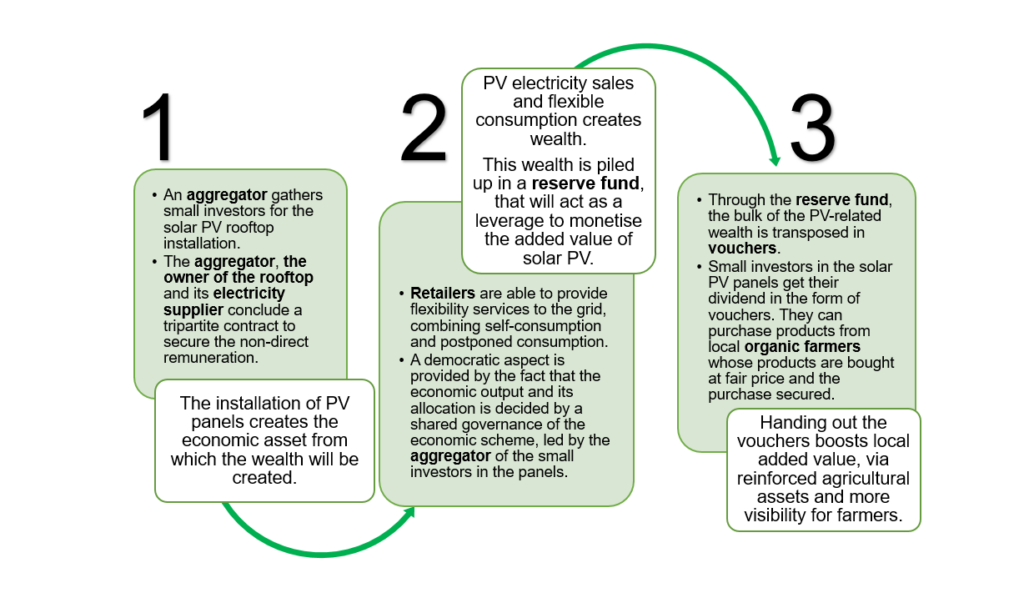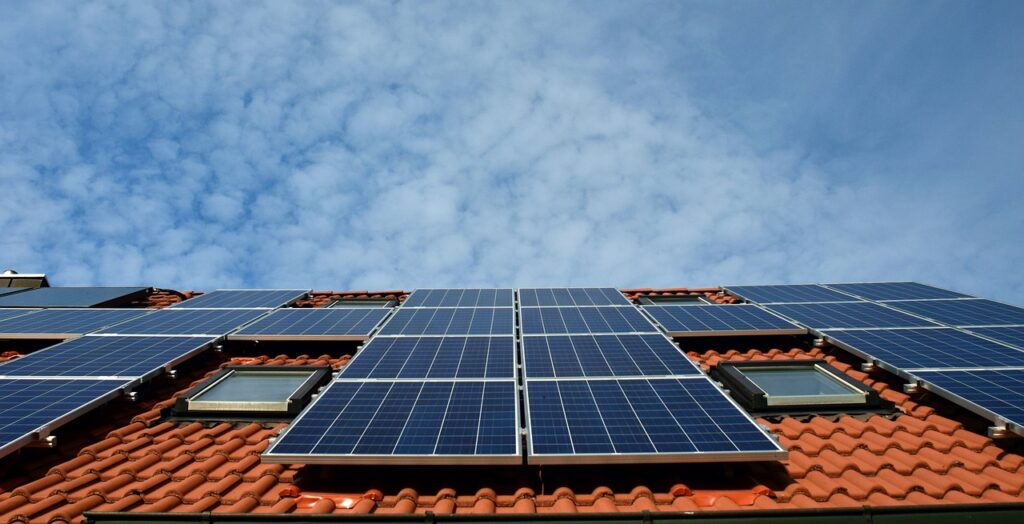It is high time for an out-of-silos approach to boost the added value from solar photovoltaic (PV) rooftop installations. This analysis suggests a new solidarity model allowing citizens, local retailers and farmers to tap into the benefits of solar electricity. Guillaume Joly reports.
The objective of the European Union (EU) is to accelerate the roll out of renewable energy installations. Besides reaching climate targets, this will help reinforcing the continent’s resilience. To do so, regulations of the energy markets need to boost electricity from solar photovoltaics (PV). We can observe that except for the low-hanging fruit of the biggest commercial roofs, there still is a mismatch between stakeholders who can invest and stakeholders who can provide PV-friendly roofs. Support and guidance are needed for investors to find viable projects and available roof areas. At the same time, as the PV energy production costs have dropped, feed-in-tariffs lost their relevance. This contributes to uncertainty for investors.
Innovative business models are needed to bridge the gap between investors and owners of rooftops suitable to PV installation. New kinds of regulations to secure investments via mutualised financial schemes are necessary to cover the risks for PV investors.
However, staying in a silo paradigm and merely financially fostering the roll out of PV panels would be a missed opportunity for citizens’ engagement in the energy transition. To engage all of society in a systemic change and ensure that renewables act as the leverage they should and can be, we need to go one step further and embed their technical deployment into co-beneficial business models.
One way is to use a monetary tool that will harness the wealth created by solar PV electricity and distribute it to other economic sectors. With this tool, solar PV might be less directly profitable to investors, and in that sense less capitalistically ‘effective’. However, the economy as a whole would benefit more, and long-term pay outs would emerge for investors, making the wealth distribution from PV value economically more efficient. The risks we need to cover are indeed much broader.
Crossed challenges
A lot of households don’t own a roof on which they could invest to benefit from solar PV. Tenants in the residential private rented sector are a good example. At the same time, large retailers across the EU own dozens of square kilometres of rooftops, parts of which still remain idle. Simply opening the roof to third-party investors with a direct revenue stream from the PV electricity sale leaves several questions open:
- How do we tackle the question of the rent for the roof area in a fair way?
- Should the electricity generated at the peak production time be consumed directly or stored or fed into the grid – and who decides about the benefits?
- How do you define a fair way to offset the losses of solar PV (when the revenue from wholesale electricity prices is low) against excess revenue from solar PV? Can other economic sectors or parts of society also benefit from it?
Among other challenges, low-income households also face a cost-of-living crisis impacting food prices. Millions of European households have had to somehow restrict their calorie intakes and number of daily meals due to inflation and higher costs. The overarching climate crisis only accentuates the state of food insecurity dozens of millions of European households, and hundreds of thousands of farmers, now live with.
How could a cross-cutting, out-of-silos business model provide security for all these stakeholders? And how could it do so while ensuring that a thriving renewable energy–based economy is harnessed to help lift other struggling sectors up, such as sustainable and affordable agriculture?
Suggested solution – the monetisation of the added value
One way forward is to work with large staples retailers, and medium and cooperative networks alike. Out of simplicity, let’s call them ‘supermarkets’. They can help embed the wealth created by solar PV on their roofs in a new, local economic circuit. This can be done via non-direct dividends from the investment, through its monetisation.
This can take the form of a dedicated currency, or vouchers. Where would the money come from? Supermarkets would also accept to pay for the PV electricity at a higher cost than from a direct investment and self-consumption use, but still at a level guaranteed to be lower than the regular electricity market prices. The difference would feed into a mutual reserve fund to compensate for the value of vouchers.
Supermarkets would both invest in the energy efficiency of their building and in a new pool of deep freezers. Supermarkets would not be paid any rent for the installation of PV panels on their roof and would bear the costs of maintenance. Supermarkets would have to schedule the energy use of their freezers to match the peak production time, to over-freeze the staples around noon, at -36°C instead of -18°C.
Then, at the time of peak consumption in the evening, the freezers would be switched off for two hours. The provision of this service would be formalised in a dynamic price contract to allow for a double dividend for the supermarkets. To do so, they would sign a tripartite contract with an energy supplier and with the investors who invested in the solar PV installation on the supermarket’s rooftop, either directly or via their mutual facilitator (or ‘aggregator’).
Such dynamic price contracts still need to be enabled to empower stakeholders in the design and roll out of new business models to optimise the use of solar PV electricity. The resulting revenues would regularly feed into and capitalise the mutual reserve fund. The fund would be used to compensate supermarkets for the issuance of the vouchers on a quarterly basis.
The aggregator of the investors could be a consumer defence organisation, a municipality, an energy community, a charity, farmers cooperatives and so on. The aggregator would play a key role in the governance of both the installation and the whole economic scheme. The aggregator would provide steppingstones for low-income households to get into the scheme, by: doubling their investment via a grant, spreading their investments over the course of several years with low monthly payments, providing advanced trusted payment that households repay over time and so on. Several financial schemes actually enable this. Besides, the aggregator’s role makes real sense once a critical mass of projects is reached, to lower the administrative costs by mutualising them.
Combining energy and food supply to create strong local ties
Supermarkets would get an indirect and spread income from the structured purchase of the PV electricity. Through the mutual reserve fund, they would transpose the bulk of its value into vouchers for investors.
The vouchers would be dedicated to the purchase of local organic food products, with accredited farmers who have implemented sustainable practices and environmental services. Investors would then benefit from a buffer on food price rises and secure their purchasing power of quality food over the lifespan of the PV panels. This would not only create loyalty from the investors as customers of the supermarket, but also from the farmers, whose production would be purchased at a fairer price with money also coming from the reserve fund. This could take the form of a quarterly compensation from the reserve fund for the planting and maintenance of hedges, ponds and other water- and biodiversity-friendly assets. And the supermarkets would have a certain leeway to play on volumes and on the use of the reserve fund to evaluate their resulting margins. Supermarkets would not lose money; they would recycle it in a determined and fair manner.
Should a farmers’ cooperative be the aggregator, then investment could also be made on the roofs of their farms’ buildings. And the purchase of their products would be facilitated via the vouchers. Only the aggregator could be retributed directly in euros, and not in vouchers, to compensate for its service.
To illustrate with a comparison, these vouchers would act as the original model of local utilities (e.g. the German Stadtwerke), where benefits from the municipal power plants were used to co-fund another key infrastructure – the electric public transport.
Cranking up the local economy

(Graph by Guillaume Joly)
Going further
- Supermarkets could organise investment in car parks that produce shade and photovoltaic electricity, as is mandatory in France now. The vouchers could be used to pay for the access of investors to an electric vehicle (EV) carpooling offer. The EV pool would provide further occasion to buffer PV production with their batteries. Customers shopping at lunch time could get a 50% rebate if they eat at a restaurant that accepts vouchers, ensuring the EV stays plugged in when the sun shines the most.
- Distribution System Operators (DSO) are now included in the scope of the Energy Efficiency Obligation Schemes (EEOS) in the latest revision of the EU’s Energy Efficiency Directive (EED). One EEOS could be to offer supermarkets tax rebates on their energy bill if they implement a PV vouchers scheme. Taxes are a good and robust incentive to act.
The views and opinions in this article do not necessarily reflect those of the Heinrich-Böll-Stiftung European Union.
